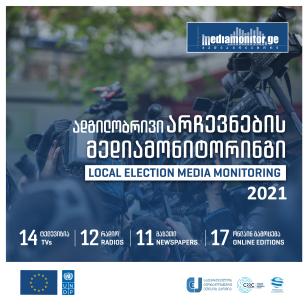Media Monitoring for 2021 Local Elections in Georgia
Media Monitoring for 2021 Local Elections in Georgia
December 14, 2021
The EU and UNDP election media monitoring examines media coverage of the 2021 local elections in Georgia in 54 media outlets (27 national and 27 regional). The research is carried out in partnership with three Georgian organizations - Georgian Charter of Journalistic Ethics, Internews Georgia and CRRC-Georgia. Media research is set to continue throughout the electoral cycle, covering an election campaign, election day and a post-election period (from July 2021 through March 2022).
Key findings (5 July – 14 November 2021):
- Deep partisan divisions between media camps have increased between the parliamentary elections in 2020 and the local elections in 2021. Some of the media outlets, which were relatively balanced last year, are now showing clear signs of political preference.
- Political divisions on television were most evident in July when homophobic pogroms and violent attacks on journalists dominated the media agenda.
- All national televisions closely followed political events, but most of them manipulated their audiences by spreading political bias and negatively portraying political forces they did not favour.
- Facebook pages of the national televisions mirrored this trend by backing certain political forces and demeaning others.
- Regional and local televisions were more focused on covering national news than local developments but failed to provide their audiences with high-quality information. News programmes were irregular and, in some cases, had to be suspended for several weeks for technical reasons.
- Polarization and political bias have increased on national radios.
- Regional radios, though less biased in their reporting, did not provide critical analysis of the events and often used unverified information.
- Both national and regional radios tried to follow journalistic standards and refrained from discriminatory or abusive language.
- As in previous years, unverified sources of information and offensive language remained an issue in national print media.
- Regional and local newspapers offered a relatively impartial account of events and a diversity of opinions.
- National digital media was less polarized and more informative and balanced, while regional and local digital media outlets lent to political favouritism and used untrustworthy information sources.
- Compared to television, political pressures and polarization were notably less evident across the entire digital media sector.
- Compared to the 2020 electoral cycle, fewer cases of gender-discriminatory language were registered during the monitoring period across all media sectors.

 Locations
Locations